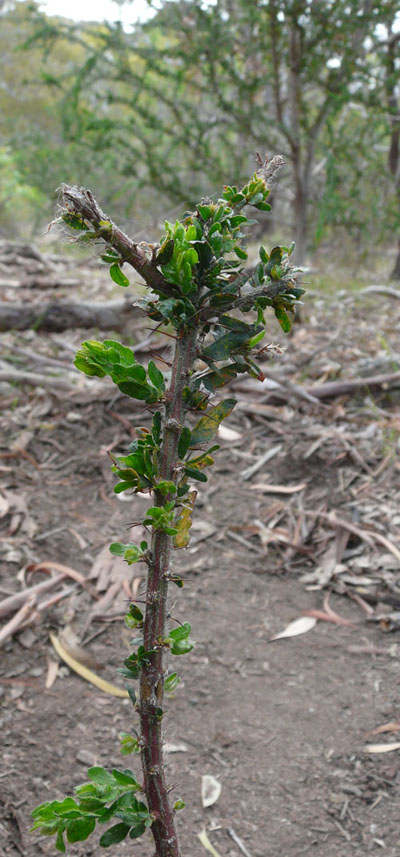
In 1985 Robertson wrote
The only abundant shrub at Gellibrand Hill State Park is Acacia paradoxa (Hedge Wattle). This species forms extensive thickets in parts of "Woodlands" and in the north-eastern section of "Factor's Land".(p. 57)
and
Acacia paradoxa is a spiny species which has proliferated since European settlement because it is untouched by livestock or rabbits. The extensive thickets of this species should be thinned out and replaced with other species of native shrubs to restore species diversity.(p. 271)
and
A. paradoxa is generally not eaten by Kangaroos or Wallabies either (but see photo) and in some places has continued to proliferate after cattle were removed. The Restoration Plan includes it in the list of species for revegetation in all areas of the park, with advice that it "should be planted in fairly dense discrete stands with a scattering of plants more widely" (page 37). The 1997 Management plan merely mentions that it is the main component of the shrub layer. Nevertheless most park managers have treated it as a weed and there have been a number of efforts to clear it. I doubt if any shrubs were ever planted in it's place as recommended by Robertson. Hedge Wattle is still the most common native shrub in the park, although there are some large patches of Drooping Cassinia.
The Species and it's Distribution
Acacia paradoxa occurs in all states. In Tasmania and Western Australia it is considered an alien. Like many Australian Wattles it is a serious weed in some other countries. According to Flora of Victoria it occurs and is native in all regions of the state except the north-west and the far east. Flora of Melbourne lists it as occurring in 26 different types of vegetation. But do we really know it's distribution before European invasion?
It was certainly widespread. The earliest field collection listed in the Atlas of Living Australia is by Oxley's 2nd Expedition in NSW in 1818, followed by Major Mitchell in 1836 at Mt. William and Stavely in western Victoria. Von Mueller collected it in South Australia in 1851 at locations including the Eyre Peninsula and the Barossa Valley, and in 1852 in Victoria on the Mt. Alexander goldfields and next to Port Phillip Bay.
All of the records in the Atlas are considered to be the same variety, although there are hybrids with other wattle species recorded. However Kloot (1985) notes early references to a particularly thorny form from Kangaroo Island, which was used as a hedge plant on the mainland before 1843 and was in widespread use in South Australia by 1850. He mentions specimens from Kangaroo Island in the Adelaide herbarium but these have not yet been listed in the Atlas.
The earliest mention I have found of Kangaroo Island Acacia in other states is in an article from 1861, which states that the best plants for hedges are Kangaroo Island Acacia and the Acacia armata, the latter being the original name for Acacia paradoxa.
An article from 1866 has:
If you are determined upon an acacia hedge, be particular in procuring the true seeds of the acacia armata. There is a great difference in the character of the plants (between that mentioned and the acacia indigenous to Victoria). The one indigenous to Kangaroo Island seldom grows over six or seven feet high, but is very close in its growth - each plant binds, as it were, with its neighbour, and cattle will not eat it. On the other hand, the Victorian acacia grows each plant almost independently of the adjoining one, and the cattle will eat it, even if other food be in the paddock; it is more easily trimmed than the former, being softer wood.
We have to assume therefore that the Kangaroo Island form has been widely planted in Victoria as well, and that genetically all plants in Victoria may be as close to the Kangaroo Island form as to the original Victorian form. Perhaps the differences between the two forms are not apparent from herbarium specimens, but apart from Mitchell's 1936 collection we cannot be sure that any specimens of the original Victorian form exist.
Also uncertain is the original distribution of the Victorian form. I have only found one published study that pertains to this, by Franco and Morgan in 2007. Franco studied Acacia paradoxa invasion in a Red Gum/Manna Gum grassy woodland at Inverleigh, Victoria, and found that most had occurred since the area was made a conservation reserve. Curiously this was attributed this to the cessation of cattle grazing despite Robertson's assertion that the A. paradoxa at Woodlands was untouched by stock. However under previous management for forestry there had been extensive clearing of shrubs. Locals considered that the wattle had originally spread from a hedge on the eastern side of the reserve.
A. paradoxa was found to occur mainly close to tracks and in areas with high soil moisture.
The age of plants was studied using growth rings. A very useful model was developed:
Age in years = 3.91 + 2.07 * diameter of stem at 10cm from ground, in cm
Some plants up to 63-66 years old were found at Inverleigh. Assuming the model is applicable at Woodlands Historic Park, the oldest plant I have found there is about 58 years old. Franco states that the study area at Inverleigh has not burnt since 1851, and this is probably also the case for most of Woodlands until it became a park. Germination at both locations therefore appears to have occurred in the absence of fire.
Should Acacia paradoxa be Controlled at Woodlands Historic Park?
Franco and Morgan make the point that management has to decide whether they wish to attempt to restore the pre-European vegetation structure, or allow the dense shrub layer to persist or increase. They state that the latter might reduce plant diversity but be beneficial for birds.
The inability for other plants to grow under dense areas of paradoxa has been given as a reason for controlling the species at Woodlands, although Weeping Grass (the most shade tolerant of the local native grasses) seems to grow under quite dense thickets. One must also consider whether bare ground under a patch of paradoxa is the result of the growth of the shrub or its cause. In any case, the same objection can be made to almost any woody vegetation. Examples in and around Woodlands include Grey Box saplings in the back paddock, River Red Gum saplings in twin dams paddock and other places in the park, the NSW species Early Black Wattle in the Weeroona Cemetery Conservation Zone, and even a few patches of Golden Wattle. There has been no intervention by park management in any of these examples.
Another reason for removal of Acacia paradoxa is because it provides rabbit harbour. Removing it in conjunction with warren ripping could be justified. Like any warren ripping this should be followed by re-vegetation.
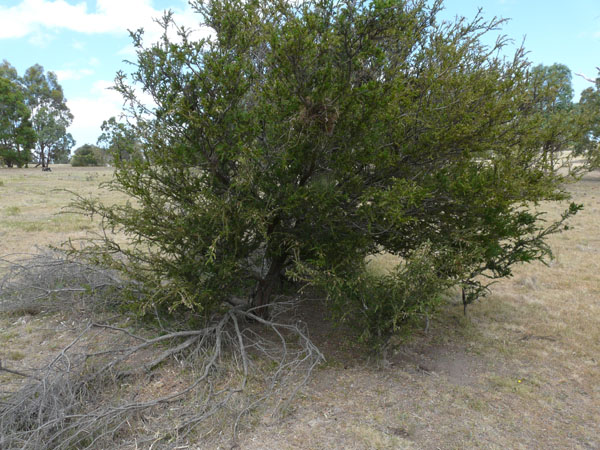
Acacia Paradoxa is certainly used for nesting by small birds such as Thorn-bills. Nests occur both in isolated plants and in thickets. The only other shrubs and trees in the park that provide similar predator-proof habitat are the weeds Boxthorn and Gorse. The somewhat spiny native shrub Tree Violet does not appear to be used for nesting, while the small tree Sweet Bursaria while occasionally spiny is much more open and rarely seems to have nests in it. If the three more prickly shrub species were eliminated then there might be a large decline in some bird species in the park.
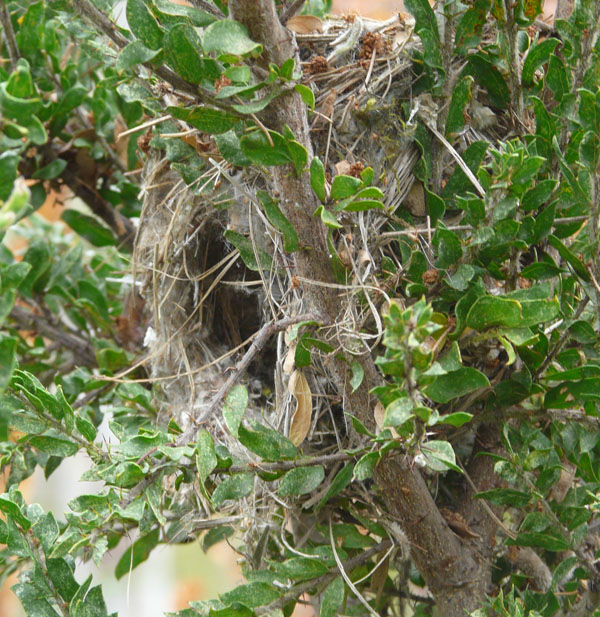
Franco and Morgan imply a choice between having lots of paradoxa leading to low plant diversity and high bird diversity, or eliminating the paradoxa leading to the reverse. However, there is no reason why the same treatment should be prescribed for the whole park. In many parts of the park the ground flora is primarily weeds. There is no ecological reason to remove paradoxa in those areas except in conjunction with rabbit control and/or revegetation as suggested by Robertson.
In places where paradoxa does threaten plant diversity, such as the water tower area described below, it should be removed but the aim need not be to eliminate it completely from the area. Individual plants are valuable as bird habitat and the species appears to spread very slowly in the absence of disturbance.
Case Studies of Clearing at Woodlands Historic Park
The Water Tower Area
This area is part of the former Greenvale Sanatorium land. Here is a time series of three satellite photos from Google Earth. The two white circles are the water towers, which are on a hilltop with a ridge extending northwards, flattening out before the top of the photo. The dark green bands on each side are Sugar Gums, while in the centre there are various trees as well as paradoxa. Soon after the first photo a prescribed burn took place, which was not hot enough to penetrate a dense patch of about 2 ha of paradoxa to the north-east of the water towers. In 2005 a forestry mulching machine was used to clear this patch, the operator being instructed to avoid trees and saplings where possible.
The second photo shows the result of both the burn and the mulching operation. Almost all paradoxa was killed one way or the other, so the dark green patches that remain are trees or saplings.
The 2009 photo from google earth is not shown but is very similar to the 2006 photo - any new paradoxa plants which had grown by this time were still too small to show up on the photo. A second prescribed burn had been programmed for about this time, but due to a change of staff it never took place. If it had, the paradoxa seedlings would have been killed.
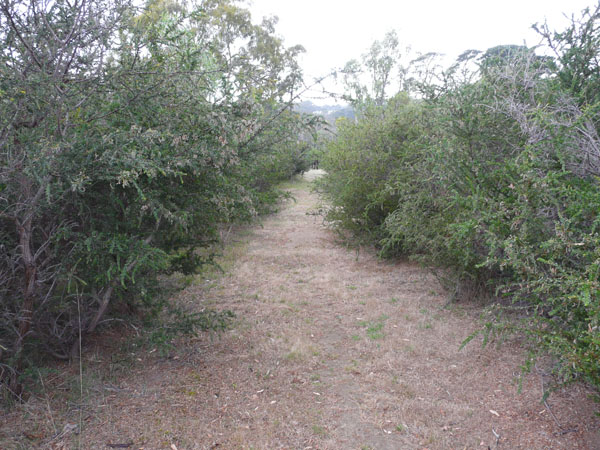
In the 2014 photo, some of the additional dark green area is due to the trees having grown, but much of it is paradoxa. The area that was cleared mechanically is still less dense than it was in 2004. However some areas that were burnt are more dense - for example just south of the track to the east of the water tower. A low intensity fire now would, like the 2004 burn, be likely to leave many patches of paradoxa untouched.
The poor dispersal ability of this species is indicated by the fact that the open grassy areas in the 2004 satellite photo still appear to be open grassy areas in the 2014 photo, with only minor incursions by paradoxa at the edges in some places. Some seeds have dispersed further - in the grassland at the upper left, there were 6 plants of paradoxa up to 20m from the edge, which appear to have germinated around the same time as the majority of paradoxa plants in the area.
Would a fire in 2009 have reduced the population of paradoxa or just delayed its regrowth? This depends on how many seeds remained in the soil from before the first fire (or the mechanical clearing operation) and how many of them germinated in the second fire. A third important factor is the amount of new seed from the plants which germinated after the first fire. In this case the amount would have been small due to low rainfall in the years after the first fire and the consequent small size of these plants in 2009.
Little data is available on the fire ecology of paradoxa. Some attributes appear in Tolsma et. al. (2007), Appendix 1, which presumably come from the Victorian Government's plant vital attributes database. However they are too vague to be of much use. In 2012 Lunt et. al. studied the site of a patchy prescribed burn which took place at Inverleigh in 2011. In areas of high fire intensity they found an average of 15.7 paradoxa seedlings per m2, while there were still about 12 seeds per m2 left in the soil (based on 128 samples with a 7 cm diameter auger). In areas of lower fire intensity there were 4.4 seedlings per m2, but a similar number of seeds remaining in the soil (based on 44 samples). More research is needed into the size of the seed bank and to find out how many seeds would germinate in a second fire.
The water tower area is an example of where paradoxa threatens plant diversity. Since the 2004 burn at least six plant species have been recorded in this area which have not been recorded elsewhere in the park, and in one case nowhere else in the greater Melbourne area. They are:
- Broad-leaf Early Nancy (Wurmbea latifolia ssp. Vanessae)
- Pussy-tails (Ptilotus spathulatus f. spathulatus)
- Common Sunray (Triptilodiscus pygmaeus)
- Slender Tick-trefoil (Desmodium varians)
- Magenta Stork's-bill (Pelargonium rodneyanum)
- Creamy Candles (Stackhousia monogyna)
Some small areas of paradoxa have recently been removed by hand to protect patches of the Pussy-tails and Creamy Candles. Another patch of Creamy Candles has been "lost" amongst the paradoxa.
Eastern Part of Park
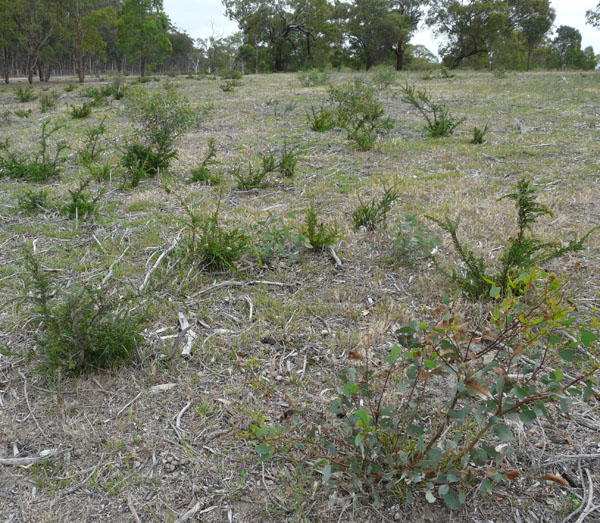
Starting in 2014 large areas of paradoxa have been mulched on the former "Woodlands" property, including on the banks of Moonee Ponds Creek. I believe this has been done as a fire prevention measure rather than for ecological reasons. As the photo shows, some of the paradoxa plants were not killed and have regrown, in contrast to the ones in the water tower area where no regrowth was observed. Paradoxa does not re-sprout unless it still has some leaves left. The plants that were not killed probably had leaves very close to the ground, most likely because they were younger and further apart than those in the water tower area.
Back Paddock
Also since 2014 Conservations Volunteers Australia have cleared paradoxa by hand from large areas of the Back Paddock, to increase the amount of grassy Eastern Barred Bandicoot habitat. Areas of Kangaroo grass which are not heavily grazed are supposed to be burnt at intervals of less than five years to maintain plant diversity and the health of the grass itself, and if this was done paradoxa would not be able to multiply in the grassland areas of the back paddock. I am assured that it is possible to burn the grass without killing the bandicoots, but nevertheless no burning has taken place in the Back Paddock for the past three years, and some areas have been unburnt long enough for the paradoxa to have reached head height.